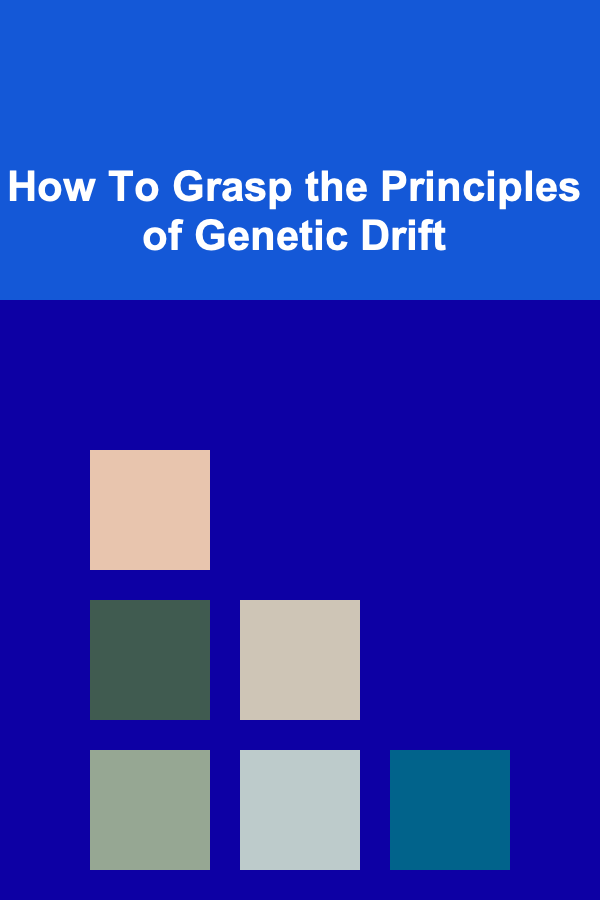
How To Grasp the Principles of Genetic Drift
ebook include PDF & Audio bundle (Micro Guide)
$12.99$5.99
Limited Time Offer! Order within the next:

Genetic drift is a fundamental concept in evolutionary biology that describes the random changes in allele frequencies within a population. Unlike natural selection, which operates on traits that increase an organism's fitness in a particular environment, genetic drift occurs due to chance events and affects all organisms, regardless of their fitness. This process can lead to the reduction of genetic diversity and even the fixation or loss of alleles over time. Understanding genetic drift is crucial for studying evolution, population genetics, and the mechanisms that influence genetic variation.
In this article, we will explore the principles of genetic drift, its causes, mechanisms, effects, and how it interacts with other evolutionary processes. We will also address the significance of genetic drift in the context of both small and large populations, its role in the genetic diversity of species, and its implications for conservation biology.
Introduction to Genetic Drift
Genetic drift refers to random fluctuations in the frequency of alleles (gene variants) within a population. These fluctuations occur without regard to the alleles' contribution to an individual's fitness or survival. The key characteristic of genetic drift is that it is entirely due to chance events rather than adaptive processes. Over time, genetic drift can lead to changes in allele frequencies, with some alleles becoming more common while others may be lost entirely from the population.
Genetic drift operates more significantly in smaller populations, where the random sampling of alleles has a larger effect. In larger populations, genetic drift is still present but tends to have a smaller impact, as the random fluctuations in allele frequencies are buffered by the large number of individuals.
The Mechanisms Behind Genetic Drift
Genetic drift operates through various mechanisms that influence allele frequencies in a population. These mechanisms include:
2.1. The Founder Effect
The founder effect occurs when a small group of individuals from a larger population establishes a new population. This new population may carry only a subset of the genetic diversity present in the original population. Due to the small sample size, some alleles may be overrepresented, while others may be underrepresented or completely absent. Over generations, the alleles carried by the founders may become fixed or lost, leading to a population that is genetically distinct from the original one.
The founder effect is particularly evident in isolated populations, such as those on islands or in small, remote communities. A well-known example of the founder effect is the population of the Amish in the United States, where a small number of individuals established the community, and as a result, certain genetic disorders, such as Ellis-van Creveld syndrome, are more prevalent in this group than in the general population.
2.2. The Bottleneck Effect
The bottleneck effect occurs when a population undergoes a drastic reduction in size due to a catastrophic event, such as a natural disaster, disease, or human activity. This sharp decline in population size results in a loss of genetic diversity, as only a small number of individuals survive to repopulate the population.
The bottleneck effect can have long-lasting effects on the genetic makeup of a population. The surviving individuals may carry only a subset of the original genetic variation, and over time, the population may recover but with reduced genetic diversity. One example of the bottleneck effect is the cheetah population, which experienced a genetic bottleneck around 10,000 years ago, leading to low genetic variation in modern cheetahs.
2.3. Random Mating and Allele Frequencies
In any population, individuals mate randomly, and the offspring inherit alleles from their parents according to the laws of inheritance. However, the genetic composition of each generation can still change due to chance events. This is particularly evident in small populations where the random mating process has a stronger influence on the overall allele frequencies. In larger populations, the effects of random mating are more likely to be balanced out by the larger gene pool.
For example, if an allele is rare in a population, it may have a very low probability of being passed on to the next generation purely by chance. This randomness can lead to the disappearance of alleles from the population, even if those alleles are neutral with respect to fitness.
The Role of Population Size in Genetic Drift
The size of a population plays a critical role in determining the impact of genetic drift. In small populations, genetic drift has a much more pronounced effect on allele frequencies. In large populations, the effects of genetic drift are less noticeable because the random fluctuations in allele frequencies are diluted by the sheer number of individuals.
3.1. Small Populations and Genetic Drift
In small populations, genetic drift can cause rapid changes in allele frequencies. Since there are fewer individuals, the random sampling of alleles can lead to the fixation or loss of alleles much more quickly than in larger populations. This can lead to a reduction in genetic diversity and a higher risk of inbreeding, which may have negative consequences for the population's overall fitness.
For example, in endangered species with small populations, genetic drift can result in the loss of rare alleles that may be crucial for the species' survival in the long term. Additionally, the loss of genetic variation can make the population more vulnerable to diseases and environmental changes.
3.2. Large Populations and Genetic Drift
In larger populations, genetic drift has a less noticeable effect because the large number of individuals means that random fluctuations in allele frequencies are less likely to have a significant impact. However, genetic drift can still cause small changes in allele frequencies over time, particularly in isolated subpopulations or in cases where bottlenecks or founder effects occur.
In large populations, the role of natural selection tends to dominate over genetic drift. This is because natural selection acts on the genetic variation present in the population, favoring alleles that increase fitness. As a result, alleles that are beneficial tend to become more common, while harmful alleles are selected against.
Genetic Drift and Its Effects on Genetic Diversity
One of the most important consequences of genetic drift is its impact on genetic diversity. Over time, genetic drift tends to reduce genetic variation within a population, as alleles are lost or fixed due to random events. This reduction in genetic diversity can have several effects on a population's ability to adapt to changing environments.
4.1. Loss of Alleles and Genetic Bottlenecks
The random nature of genetic drift means that some alleles may become fixed in a population, while others are lost entirely. In extreme cases, this can lead to a decrease in the overall genetic diversity of the population, making it less adaptable to environmental changes. For example, a population that has undergone a bottleneck effect may have a limited genetic pool, which can lead to inbreeding depression and an increased susceptibility to diseases.
4.2. Implications for Evolution
Genetic drift can also influence the course of evolution. While natural selection acts on beneficial traits, genetic drift can cause the fixation of neutral or even harmful alleles by chance. This means that evolution is not always driven by adaptive changes but can also be shaped by random processes.
In populations that are isolated or experience frequent bottlenecks, genetic drift can have a significant impact on the genetic makeup of the population, potentially leading to the emergence of new traits that were previously not present in the original population. Over time, genetic drift can contribute to the divergence of populations and the formation of new species.
Genetic Drift in the Context of Conservation Biology
In conservation biology, understanding genetic drift is crucial for managing endangered species and maintaining biodiversity. Small populations of endangered species are particularly vulnerable to the effects of genetic drift, as they are more likely to experience a loss of genetic diversity and an increased risk of inbreeding.
Conservation efforts often focus on increasing the effective population size of endangered species to reduce the impact of genetic drift. For example, captive breeding programs may be established to help maintain genetic diversity and prevent the loss of valuable alleles. Additionally, habitat restoration and the establishment of wildlife corridors can help promote gene flow between isolated populations, reducing the effects of genetic drift and increasing the overall genetic diversity of a species.
Conclusion
Genetic drift is a crucial process in evolutionary biology that shapes the genetic makeup of populations over time. It occurs due to random events and affects both small and large populations, with more pronounced effects in smaller populations. While genetic drift does not operate based on the fitness of alleles, it plays a significant role in the reduction of genetic diversity and the divergence of populations.
Understanding the principles of genetic drift is essential for researchers and conservationists who work to preserve biodiversity and study evolutionary processes. By considering the effects of genetic drift alongside other evolutionary mechanisms such as natural selection and gene flow, we can gain a deeper understanding of how populations evolve and adapt to their environments.
In the context of both natural populations and conservation efforts, the principles of genetic drift help us understand the complex interplay of chance, survival, and adaptation that drives the evolution of life on Earth.

How to Clean and Freshen Up Your Bedding
Read More
How to Create a Luxe Feel on a Budget with Accessories
Read More
How to Handle Pet Waste Disposal in Your Home
Read More
How to Optimize Routes for Faster and More Efficient Deliveries
Read More
How to Tie Dye with Shimmer & Metallic Colors
Read MoreOther Products

How to Clean and Freshen Up Your Bedding
Read More
How to Create a Luxe Feel on a Budget with Accessories
Read More
How to Handle Pet Waste Disposal in Your Home
Read More
How to Optimize Routes for Faster and More Efficient Deliveries
Read More